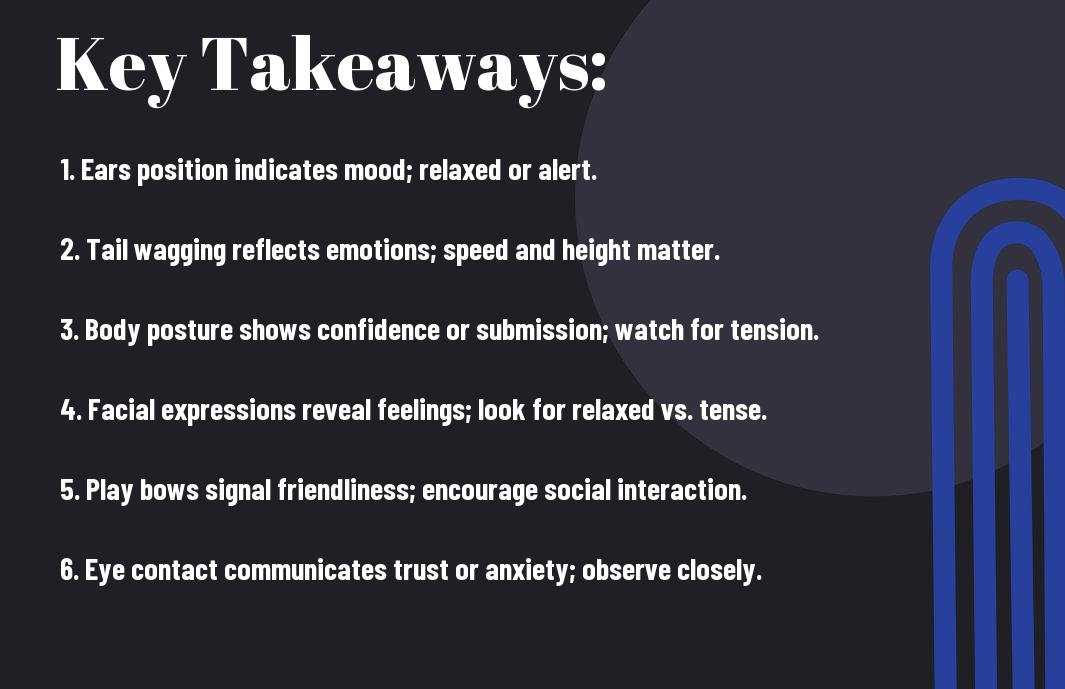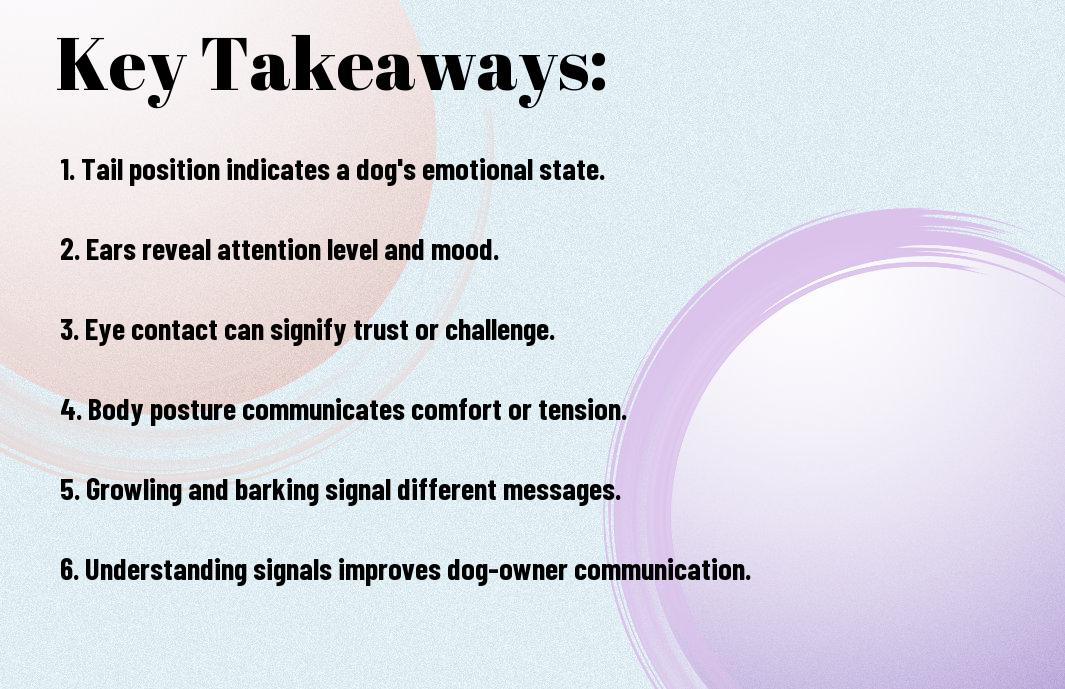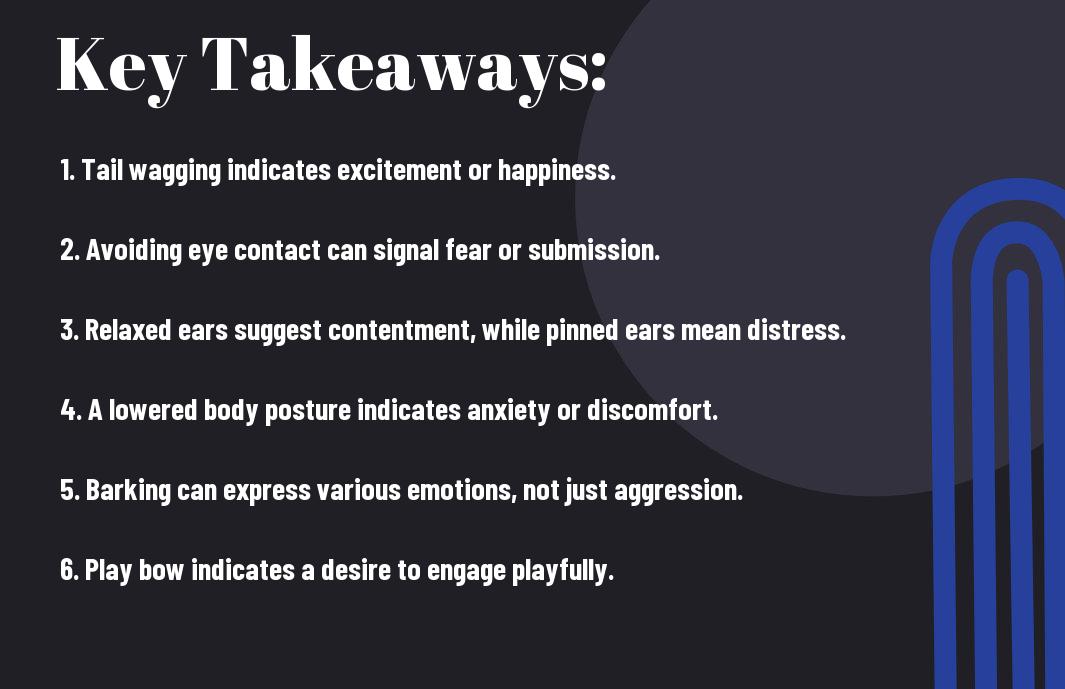Most dog owners often find themselves puzzled by their furry friends’ actions and reactions. Understanding your dog’s body language can significantly enhance communication between you and your pet. By recognizing key signals—such as tail movements, ear positions, and facial expressions—you can better address your dog’s needs and feelings. This knowledge not only helps you foster a stronger bond but also keeps both you and your dog safe in various situations. Let’s probe into the fascinating world of canine communication together!

The Basics of Canine Body Language
The Importance of Understanding Your Dog
The relationship you have with your dog is deeply enriched when you understand their body language. Dogs communicate largely through their bodies, and recognizing these signals can help you respond appropriately to their needs and feelings. A wagging tail, for example, can convey excitement or happiness, but it can also indicate nervousness depending on the rest of their body posture. By being attentive to these cues, you can foster a stronger bond built on trust and mutual respect, making your interactions more enjoyable for both of you.
Additionally, understanding your dog’s body language can help prevent misunderstandings that could lead to negative experiences, such as aggression or anxiety. When you can detect whether your dog is feeling relaxed, threatened, or playful, you can guide their behavior and create a safer environment. This awareness is necessary for preventing situations where your dog might feel overwhelmed or unsafe, ultimately leading to a more harmonious living situation.
Key Body Language Indicators
Before diving deeper into canine body language, it’s necessary to familiarize yourself with some key indicators that convey your dog’s emotional state. For example, a dog that has relaxed ears and a loose body posture is generally feeling content and safe. Conversely, a dog that has stiff ears, a tense body, or a lowered tail might be signaling discomfort, fear, or aggression. Being aware of these signs allows you to make informed decisions about how to interact with your pet in various situations.
Language is a rich form of communication that varies by context. Consider the position of your dog’s tail, which can express a range of emotions. A high, wagging tail usually indicates excitement, while a low, tucked tail could signal fear or submission. Additionally, the angle and looseness of their mouth can also provide valuable insights; a dog with a relaxed mouth and visible tongue is likely at ease, while a closed mouth may indicate tension. By observing these key indicators, you can effectively interpret your dog’s feelings and respond to their needs appropriately, ensuring their well-being and happiness. Understanding this important communication can make a remarkable difference in your shared experiences.
Facial Expressions
While exploring the world of canine communication, understanding your dog’s facial expressions is vital. Your dog’s face can convey a wide range of emotions, enabling you to decode their feelings and intentions more accurately. A keen observer of these expressions can foster a deeper bond with your furry friend, ensuring their needs and emotions are met effectively.
Eyes: The Window to Your Dog’s Emotions
Any dog owner will tell you that they can often gauge how their dog feels just by looking into their eyes. Soft, relaxed eyes indicate comfort and contentment, while a dog displaying wider pupils and a hard gaze may be feeling threatened or anxious. It’s important to pay attention to how your dog’s eyes change in different situations, as this can provide insight into their emotional state.
Additionally, the direction of your dog’s gaze can also communicate distinct emotions. A dog that avoids eye contact is often feeling submissive or fearful, while those who stare directly at you may be expressing confidence or seeking your attention. Recognizing these subtle shifts in your dog’s eye expressions can help you respond appropriately to their emotional needs.
Ears: Position and What They Reveal
Above all, your dog’s ears can tell a rich story about their current mood. Dogs with ears that are perked up are usually alert and interested in what is happening around them. On the other hand, ears that are flat against the head typically indicate fear, submission, or anxiety. Observing these positions can help you understand when your dog feels threatened or is in a relaxed state.
Emotions can also be deduced from the temporal positioning of your dog’s ears. For instance, if your dog’s ears are cocked slightly to the side, it can mean that they are feeling curious or are assessing their surroundings. Conversely, if their ears are pushed forward and stiff, they may be feeling aggressive or ready to confront a perceived threat. By closely observing these ear positions, you will gain deeper insights into your dog’s feelings in various environments.
Muzzle: Understanding Mouth Movements
Facial expressions are often emphasized through a dog’s muzzle, where mouth movements can reveal a lot about their emotional state. If your dog’s mouth is relaxed and slightly open, it usually signifies that they are calm and at ease. In contrast, a tightly closed mouth can potentially indicate stress or unease, revealing that your dog may be feeling defensive or apprehensive.
It is also helpful to note the presence of panting or lip licking, as these can be signs of discomfort or anxiety. Dogs that are showing their teeth or have a curled lip might be signaling aggression or a warning. Understanding these signals can allow you to respond to your dog’s emotional landscape and ensure their comfort and safety in different situations.
Body Posture
All dog owners should pay attention to their dog’s body language, as it speaks volumes about their emotional state. Understanding your dog’s posture can help you learn how they are feeling in various situations. Observing both a relaxed and a tense posture can give you insights into their comfort level and any possible stressors in their environment.
Relaxed vs. Tensed Posture
Any dog exhibiting a relaxed posture will often be standing or lying down with a loose body, and their limbs will not be stiff. Their head will be at a natural level, and the ears are likely to be in a neutral position, indicating that they are comfortable and at ease. This is an excellent time for bonding and play, as your dog is signaling that they are open to interaction.
On the other hand, when your dog shows a tense posture, you may notice signs such as a stiff body, raised hackles, or tense limbs. Their ears might be pulled back, and they may also avoid eye contact. This indicates that your dog could be feeling threatened or anxious, signaling a need for caution or a change in environment.
Tail Position and Its Implications
Position and movement of your dog’s tail can reveal significant information about their emotional state. A tail that is held high and wagging vigorously typically indicates excitement or happiness, while a tail that’s low or tucked between the legs can be a sign of fear or submission. Keep in mind, however, that not all tail wags are positive; a stiff and quick-wagging tail can signal agitation or irritation.
Also, observing the tail position in different situations is key to understanding your dog’s feelings. For example, a dog with a “flagged” tail that is high and quickly wagging around the body may be displaying a greeting behavior, while a tail that is held still could indicate uncertainty or alertness. Identifying these subtleties can equip you with the knowledge to respond appropriately to your dog’s needs.
The Significance of Weight Distribution
Body posture, particularly weight distribution, reveals a lot about your dog’s state of mind. When your dog leans forward or shifts their weight onto their front legs, it often illustrates eagerness or excitement, suggesting they may be ready to engage with their environment or play. Conversely, if your dog is leaning back or sitting heavily on their haunches, it may indicate hesitance or a desire to retreat.
Due to varying situations, understanding how weight is distributed can be a guiding factor in interpreting your dog’s mood. For instance, if they are standing with their weight centered and relaxed, they are likely calm and comfortable. But if they are shifting their body away and leaning back, they could be signaling discomfort or a desire to distance themselves from what is bothering them. Recognizing these cues is instrumental in establishing effective communication with your dog.
Movement and Distance
Now, understanding how your dog moves in relation to people and other animals can provide vital insights into their feelings and intentions. Movement is a key aspect of canine body language, and it encompasses both approaching and retreating behaviors. By observing how your dog interacts with their environment, you can interpret their emotional state and gauge their level of comfort or unease.
Approaching vs. Retreating Behaviors
The way your dog approaches or retreats can tell you a lot about their mindset. When your dog eagerly moves towards you, with a relaxed posture and wagging tail, it signifies excitement and affection. In this case, your dog is likely engaging positively and wants to interact. Conversely, if your dog is backing away or moving slowly, it could indicate fear or discomfort. Look for other signs, like lowering their head or tucking their tail, which accompany these movements to better understand their emotional state.
Understanding these behaviors in the context of movement will allow you to adjust your actions accordingly. If your dog is retreating, giving them space might be necessary to help them feel more secure. Conversely, if they are approaching with a lively demeanor, encouraging interaction can strengthen your bond.
The Importance of Personal Space
Approaching someone too quickly or invading their personal space can be overwhelming, not just for people but also for dogs. Every dog has its own threshold for personal space, and it’s imperative to recognize and respect this boundary. When your dog is in a comfortable distance from you or another pet, they are likely to feel secure and content. If they feel their space is being invaded, it may lead to stress or defensive behavior.
It is also important to note that some dogs may require more personal space than others, particularly if they are not socialized well or have had negative experiences in the past. Understanding this individual necessity helps you create a nurturing environment where your dog can flourish.
The Role of Play Bow and Other Signals
Against all odds, your dog shows enthusiasm through playful movements, and one of the most well-known signals is the play bow. When your dog lowers their front legs while keeping their rear end elevated, it conveys an invitation to engage in play. This posture signifies that they are approaching you in a non-threatening manner and are ready for fun.
With other movements, like a loose, wagging tail and an open mouth, your dog signals that they are in a playful mood. Recognizing these signs is important for fostering a positive relationship with your dog. By engaging with them when they exhibit these playful signals, you strengthen your bond and create a joyful atmosphere for interaction.
Vocalizations and Their Meanings
Unlike other animals, dogs have a unique way of communicating, and their vocalizations can reveal a lot about their emotions and intentions. Understanding these sounds will deepen your connection with your furry friend and allow you to respond appropriately to their needs. Dogs use a diverse range of sounds, including barks, whines, and growls, each with distinct meanings based on context, tone, and frequency.
Barking: What Different Types Indicate
Above all, barking is the most common way a dog communicates. However, not all barks are the same; different types of barks can indicate various feelings or alertness levels. Here’s a breakdown of the types of barks you may encounter:
| Type of Bark | Meaning |
|---|---|
| Alert Barking | Your dog is likely trying to warn you of something outside, such as a stranger approaching. |
| Playful Barking | This is usually higher-pitched and accompanied by excited body language. |
| Fearful Barking | Your dog may be feeling threatened or scared, usually accompanied by a lowered body posture. |
| Complaint Barking | This occurs when your dog wants attention or is expressing boredom. |
| Loneliness Barking | Often it means your dog is feeling left out or anxious when alone. |
Knowing the differences can help you respond effectively to your dog’s emotional state and needs.
Whining and Whimpering: Emotional Signals
One of the more subtle forms of vocalization is whining or whimpering, which often indicates your dog is feeling anxious, scared, or in need of attention. This vocalization can often be a way for your dog to express discomfort or a request for help, perhaps signaling that they need to go outside or that they feel unwell. It becomes important to pay attention to the context in which your dog is whining to interpret their feelings accurately.
With close observation, you’ll notice that different pitches and lengths of whines can indicate varying levels of distress or excitement. For instance, a high-pitched whine may signal acute anxiety or urgency, while a lower, softer whimper might denote mild discomfort or a wish for affection. By tuning into these signals, you can better meet your dog’s needs.
Growling: A Warning or Playful Gesture?
Indicate whether a growl is stemming from a place of fun or a protective instinct can be confusing. Some dogs growl while playing, which is usually accompanied by a wagging tail and playful posture. However, it’s important to interpret the growl accurately, especially if it sounds low, deep, or is accompanied by a stiff body posture, as this may signal discomfort or a warning.
Types of growls can vary significantly and should be evaluated in context. Playful growling is often lighter and more vibrant, while a warning growl typically has a deeper tone, indicating that your dog is serious about wanting space or expressing displeasure. Being attentive to these nuances allows you to navigate interactions more safely, ensuring both enjoyment during play and safety during stressful situations.

Social Interactions
Keep in mind that social interactions are key for your dog’s emotional and mental wellbeing. Understanding how your dog communicates with others can prevent misunderstandings and ensure positive experiences. By paying attention to the signs your dog displays during social encounters, you can enhance both their happiness and safety.
Reading Signals When Meeting Other Dogs
To effectively read signals when your dog meets other dogs, it’s important to observe their body posture and movements. For instance, a relaxed stance with a wagging tail typically indicates that your dog is open to socializing. However, if you notice a low tail, stiff body, or raised hackles, it’s wise to proceed with caution. These signals can indicate fear or aggression, which could escalate into conflict.
Additionally, closely monitor how your dog responds to the other dog’s behavior. If the other dog approaches with a low posture and submissive behavior, your dog may feel more at ease. However, if the other dog is overly dominant, you need to intervene, as this could lead to tension. Recognizing these cues can help you guide safe and enjoyable interactions.
Interactions with Humans: Greeting Behaviors
For greeting behaviors with humans, watch how your dog approaches you and others. A dog that approaches with a relaxed body and slightly wagging tail is displaying a positive attitude. Conversely, if your dog freezes, tucks their tail, or turns away, they may be feeling uncomfortable or threatened. Understanding these signals can help you facilitate a more effective and positive interaction.
Interactions may also vary depending on your dog’s level of trust and their experiences with people. For example, if your dog frequently jumps or barks excitedly upon seeing you, they are likely expressing enthusiasm and affection. Alternatively, if your dog remains distant or hesitant, it may indicate that they need more time to build confidence in social settings. Observing these greeting behaviors will enable you to adjust your approach for a more favorable outcome.
Understanding Pack Dynamics
Among dogs, social structures often resemble a pack mentality, where behaviors and signals are important for maintaining harmony. When your dog meets other dogs, you’ll observe a variety of signaling behaviors, such as asserting dominance, showing submission, or testing boundaries. Recognizing these dynamics is vital, as it allows you to intervene or provide support if necessary, especially in more complex social situations.
Interactions within a pack can shift rapidly, and dogs will often communicate with each other through body language and vocalizations. It’s important to recognize that a dog who displays excessive dominance or fear may not be the best fit in all social environments. Understanding these dynamics will guide you in providing the right settings for your dog to thrive socially.

Common Misinterpretations
Despite your best intentions in understanding your dog’s body language, you may occasionally misinterpret their signals. It is easy to confuse their behaviors, leading to unnecessary confusion or even conflict. Being aware of these common misinterpretations can help you respond appropriately and foster a stronger bond with your dog.
Misreading Playfulness for Aggression
Above all, it is vital to recognize that your dog’s body language can sometimes be misleading, particularly when it comes to playfulness versus aggression. Many dog owners misinterpret a playful dog’s excited barking, rapid tail wagging, or exuberant movements as signs of aggression. In fact, a dog may display behaviors that look aggressive, like growling or showing teeth, during play. Understanding the context of these behaviors, such as the presence of another playful dog, is imperative in preventing clashing between pets.
The key indicators of playfulness include a relaxed body posture, wagging tail held in a non-threatening way, and playful vocalizations. By observing these details, you can differentiate between a friendly game and a potentially dangerous situation.
Distinguishing Between Fear and Submission
To effectively communicate with your dog, it’s important to accurately distinguish between fear and submission. Both fear and submission can result in similar behavioral signs, like cowering, lowered body positioning, or a tucked tail. However, a fearful dog typically exhibits signs of distress, including panting, wide eyes, and reluctance to approach or engage. In contrast, a submissive dog seeks to appease by making itself smaller and may even roll over to show its belly.
Understanding the subtle differences in these behaviors is key to addressing your dog’s specific needs. For instance, if your dog is fearful, you may need to provide comfort and reassurance, while a submissive dog may benefit from positive reinforcement to build confidence.
Understanding these distinctions allows you to respond appropriately, whether that means offering comfort or helping your dog feel more secure and confident.
The Dangers of Over-analyzing Dog Behavior
Fear of misinterpreting your dog’s behavior can lead to a dangerous habit of over-analyzing each action. While awareness of body language is beneficial, constantly second-guessing your dog’s behavior can create a tense environment for both of you. This heightened stress may lead to an increase in your dog’s anxiety, or worse, reinforce fearful or submissive behaviors. You should aim to observe your dog in various environments and situations rather than scrutinize every move they make.
Over-analysis can turn natural behaviors into anxious or fearful reactions. Your dog may feel the weight of your worry, affecting their overall demeanor and your interaction with them. Keep your observations grounded, focusing on the patterns and context to foster a healthier relationship.
Aggression can sometimes stem from an owner’s misinterpretation of their dog’s behavior, leading to severe consequences for both you and your pet. Being overly cautious can inadvertently heighten tension, causing your dog to react defensively. Instead of fearing every growl or bark, create a relaxed atmosphere that allows you to enjoy your time with your dog, while also being mindful of appropriate signals.
Final Words
Ultimately, understanding your dog’s body language equips you with the ability to enhance your bond and foster a positive relationship. By paying attention to your dog’s posture, ear position, tail movements, and facial expressions, you can gain insight into their emotions and needs. This awareness empowers you to respond appropriately to their feelings, whether they are excited, anxious, or seeking comfort. Recognizing these non-verbal cues can help you manage situations better, reducing conflicts and ensuring your dog’s well-being.
Your dog’s body language acts as a window into their thoughts and feelings, allowing you to bridge the communication gap between species. The more you practice deciphering their signals, the more attuned you will become to their inner world. By committing to this understanding, you not only enhance your dog’s quality of life but also enjoy a deeper, more fulfilling companionship. Ultimately, your dedication to learning this silent language will lead to a harmonious relationship built on trust and respect.
FAQ
Q: How can I tell if my dog is feeling anxious or stressed?
A: There are several signs to look for when assessing your dog’s anxiety or stress levels. Common indicators include excessive panting, pacing, or hiding. You may also notice your dog’s ears pulled back, a wagging tail held low, or avoidance behaviors, such as turning away from you or other people. Pay attention to their body posture—if your dog appears tense, with a stiff body or a lowered head, it may be feeling uncomfortable. Understanding these signals can help you provide comfort and support during stressful situations.
Q: What does it mean when my dog shows its belly?
A: When a dog rolls over and exposes its belly, it can indicate a few things. Often, this behavior is a sign of submission or trust; the dog feels safe enough to expose a vulnerable part of its body. However, it can also be an invitation for play or a request for a belly rub. Observe the context in which this behavior occurs—if your dog seems relaxed and happy, it’s likely a positive gesture, while a stiff body or wide-eyed expression might suggest discomfort or a readiness to protect itself.
Q: Why does my dog bark or growl when interacting with other dogs?
A: Barking or growling during interactions with other dogs can be a form of communication. These sounds can express excitement, fear, or frustration. For example, a dog might bark out of enthusiasm when greeting a new friend, or it might growl to communicate discomfort or warn another dog to keep its distance. It’s important to closely observe other body language cues, such as tail position and posture, to better understand the dog’s intent. Socialization plays a key role in helping your dog interact appropriately with others, so consider carefully supervised playdates to help them learn proper social cues.










